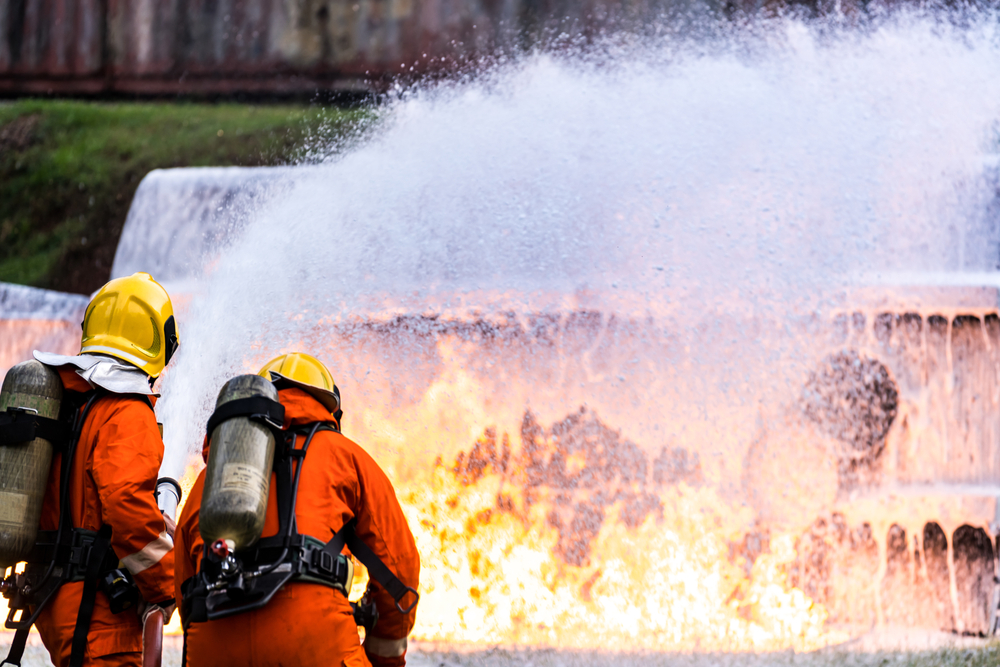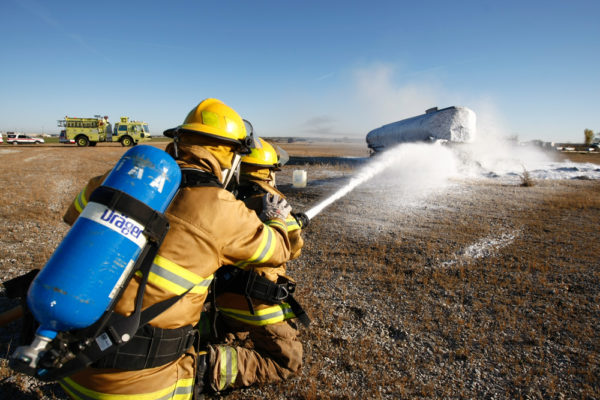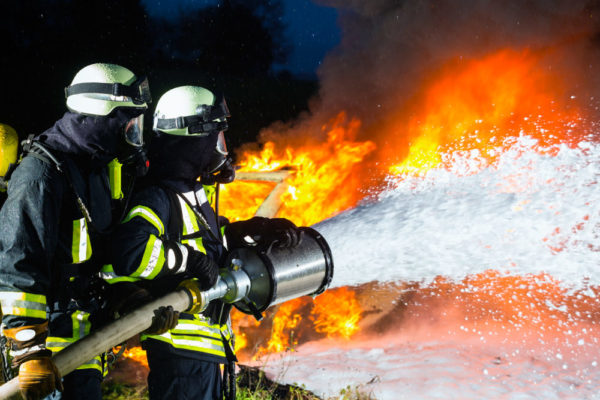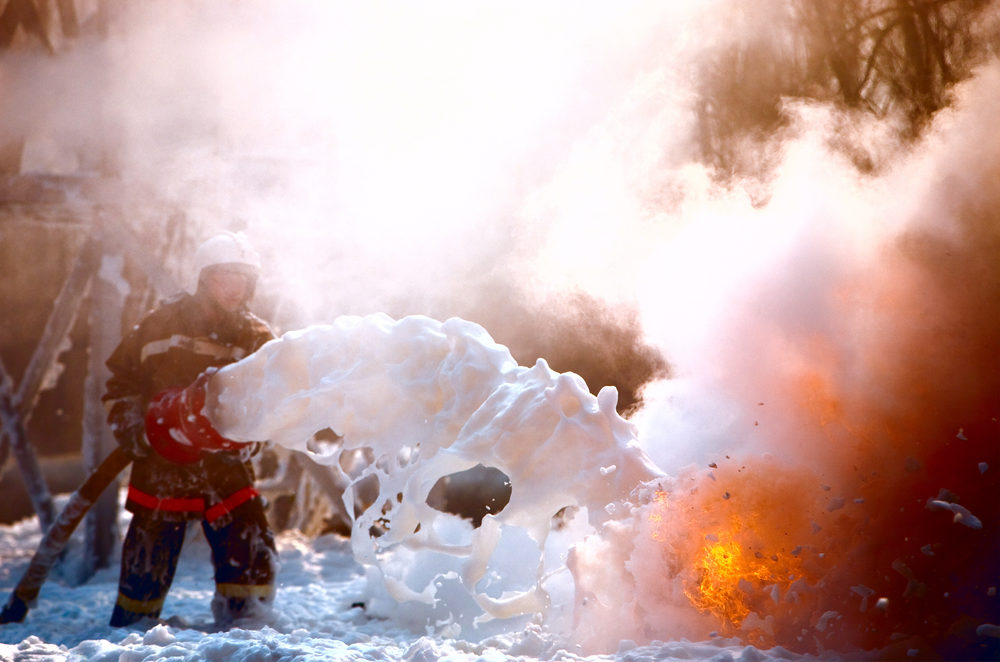Firefighting Foam Lawsuits
A suppressant foam used to extinguish hard-to-control fires has been linked to cancer and other serious illnesses. Aqueous film-forming foam (AFFF) is water-based and made of synthetic foaming agents, solvents, and other surfactants. AFFF has been utilized for decades by firefighters, manufacturers, and the aviation industry. A fire caused by petroleum or another highly flammable liquid spreads quickly and can’t be easily extinguished with water. Once AFFF is mixed with water and released on flames, it creates a film that cools the fire and smothers it, which leaves the blaze oxygen-starved and kills it quickly. The foam’s firefighting benefits are proven, which is why it’s so prevalent. But its human health toll is in question after concerning findings of some of the chemicals used in the product.
Table of Contents
Thousands of firefighters and civilians have alleged that AFFF exposure caused them to develop breast cancer, kidney cancer, ulcerative colitis, tumors, testicular cancer, pancreatic cancer, prostate cancer, and other health conditions. These firefighters have come forward in droves to sue multiple AFFF manufacturers like Chemours, 3M, and DuPont in hopes of recovering financial damages.

The plaintiffs say that the foam manufacturers knew that AFFF chemicals were dangerous but failed to warn the public adequately. Lawsuits have been consolidated into multidistrict litigation (MDL) in South Carolina federal court. Instead of cases being tried individually across the country, they will be handled by one judge in the same court to speed up the settlement process. Additionally, multiple cities and states have sued manufacturers to recoup the cost of AFFF cleanup.
What is Aqueous Film-Forming Foam (AFFF)?
 Firefighting foam falls into two categories: Class A or Class B. Class A foam is used to fight fires caused by brush, wood, and paper, and it is frequently utilized when extinguishing wildfires. Class B foams are used for fire training and fire suppression, and they are frequently found at airports and military training sites. These foams are either fluorinated or fluorine-free. Fluorinated foam contains per- and polyfluoroalkyl substances, commonly known as PFAS. These substances are the active ingredient in the surfactants that make AFFF effective. PFAS are often called “forever chemicals” by scientists because they take hundreds of years to break down in the environment.
Firefighting foam falls into two categories: Class A or Class B. Class A foam is used to fight fires caused by brush, wood, and paper, and it is frequently utilized when extinguishing wildfires. Class B foams are used for fire training and fire suppression, and they are frequently found at airports and military training sites. These foams are either fluorinated or fluorine-free. Fluorinated foam contains per- and polyfluoroalkyl substances, commonly known as PFAS. These substances are the active ingredient in the surfactants that make AFFF effective. PFAS are often called “forever chemicals” by scientists because they take hundreds of years to break down in the environment.
In 1960, the U.S. Navy and 3M jointly developed AFFF. Three years later, the Navy sought a patent for the foam. In 1967, the Navy began to use AFFF aboard its vessels. Early on, it became apparent that the foam might be detrimental to human health and the environment. Internal documents show that 3M had evidence in the 1970s that PFAS could build up in human blood and cause health problems. Animal studies on monkeys and rats showed that PFAS caused liver damage and lesions on internal organs. 3M did nothing and didn’t publish these potentially alarming results. The manufacturer didn’t warn the general public about the results of these studies, and firefighters continued to be exposed to AFFF without knowledge that it could pose a health risk.
Firefighters aren’t the only people who might use AFFF while on the job. A wide variety of industries rely on the foam, and it is commonly kept on-hand at places like:
- Airports
- Municipal services
- Oil refineries
- Military bases
- Mining facilities
- Shipyards
- Petroleum processing facilities
- Warehouses
- Oil refineries
- Offshore platforms
See Also: Water Contamination at Camp Lejeune
Is AFFF Toxic?
In 1974, a report from the Navy considered whether military ships should seek out AFFF alternatives because of the potential effects. The foam remained on the market and continued to grow in popularity. In 1980, the Air Force began to explore the possible toxicity of AFFF and found in animal studies that exposure to the foam could cause cell damage. In 1991, the Army Corps of Engineers declared AFFF hazardous and instructed one military base to replace it with a non-hazardous option.
In 1997, the military started to take the potential threat from AFFF more seriously. The Army told its soldiers to treat it as hazardous waste, and the Navy began to search for foam alternatives that wouldn’t contain PFAS. In 2015, the Department of Defense started to move away from using aqueous film-forming foam that contained PFAS. In 2018, Washington banned the manufacture and sale of PFAS-based foam suppressants. States including California, Illinois, and Connecticut have followed suit. Some of these laws allow exceptions for chemical plants, the military, and petroleum terminals.
These measures may be too late for firefighters who weren’t adequately warned about the potential hazard. In 2018, a firefighter testified at a Senate hearing that AFFF was thought to be so safe that his crew used it to wash fire trucks and station floors. He recommended additional studies on the effects of PFAS and monitoring programs for firefighters exposed to AFFF. One former firefighter diagnosed with terminal cancers after using AFFF while in the Air Force said he was told it was “just soap suds.”
PFAS Chemicals Debate
PFAS chemicals aren’t unique to fire suppressant foam and are found in everyday life. PFAS is a group of thousands of chemicals invented more than 80 years ago and commercially used since the 1940s. They are found in household items like non-stick cookware, stain-repellent fabric, food packaging, and cosmetics. PFAS chemicals have a carbon-fluorine bond that repels both oil and water, which makes them effective and is why they’re widely used. As a result, it’s difficult to avoid exposure. One study found that 98% of Americans have some level of PFAS in their blood.
The environmental impacts of PFAS have been a point of discussion in recent years. They don’t break down naturally and easily contaminate soil and water supplies. These chemicals affect wildlife and accumulate in animals exposed to them, leaving them unsafe to eat. A health advisory from the U.S. Environmental Protection Agency (EPA) warns that exposure to PFOS and PFOA, two of the most common types of PFAS, can cause adverse health effects like liver tissue damage, changes in cholesterol and thyroid levels and testicular and kidney cancer.
The human health toll has led lawmakers to question whether the chemicals should be outlawed entirely. At low levels, PFAS exposure isn’t thought to cause serious harm, but health agencies disagree on what constitutes a safe level. A bipartisan bill introduced in the U.S. House last year aimed to ban PFAS from food packaging. Organizations like Toxic-Free Future and the Environmental Working Group have applauded the efforts to restrict PFAS use, but the legislation hasn’t gained traction. The Keep Food Containers Safe from PFAS Act was referred to a committee and hasn’t advanced further.
Last October, the White House announced a multi-step effort to reduce PFAS pollution. The plan includes a $70 million investment from the Department of Defense into a PFAS-free firefighting foam, along with news that the Federal Emergency Management Agency (FEMA) will look into the firefighting foams used for emergency response scenarios. FEMA also awarded the University of Arizona a grant to study how PFAS exposure has affected firefighters.
Dangers of AFFF Exposure 
AFFF health risk depends on how much someone is exposed to and the duration of the exposure. Firefighters are particularly susceptible to illness because they are around the foam regularly throughout their careers. The foam can be absorbed through the skin, ingested, or inhaled. A firefighter wearing personal protective equipment may still be exposed to dangerous levels of PFAS through firefighting foam. The health effects of exposure aren’t always immediately apparent, but studies have shown that people exposed to AFFF are more likely to develop many health problems, including those listed below.
- Thyroid disease
- Testicular cancer
- Kidney cancer
- Bladder cancer
- High cholesterol
- Fertility issues
- Liver damage
- Ulcerative colitis
Some of these conditions might be manageable with treatment and medication, but others can drastically reduce the quality of life and impact someone’s life expectancy. For pregnant women, AFFF exposure increases the risk of potentially devastating complications. It can affect placental function, leading to low birth weight, changes in fetal development, and higher chances of stillbirth. A pregnant woman exposed to PFAS also has a higher chance of developing preeclampsia or high blood pressure.
Firefighter Foam Lawsuits
The scientific consensus that AFFF contains dangerous chemicals and creates health hazards has grown. Those affected by the product are taking legal action against the chemical manufacturers who they say knew the foam was toxic and could have long-term adverse effects. AFFF manufacturers have faced multiple claims related to PFAS. In 2017, manufacturers DuPont and Chemours paid $670.7 million to settle thousands of toxic exposure lawsuits. In 2020, DuPont paid $50 million to an Ohio man who developed testicular cancer after drinking PFOA-contaminated water.
Last year, residents in Peshtigo, Wisconsin, settled with Tyco Fire Products and two other companies for $17.5 million over AFFF exposure. The residents alleged that PFAS chemicals from AFFF contaminated private drinking water wells, leading to property damage and causing people to develop injuries.
In 2018, a judicial panel created multidistrict legislation, or MDL, to efficiently handle the cases against foam manufacturers. Some plaintiffs also sued the government and the U.S. Air Force. The number of cases in the MDL has multiplied. In early 2021, there were 950 cases. By the end of the year, there were more than 1,800. The first test trial in the group is expected to go to trial in January 2023. The results of these bellwether trials will set an expectation for future settlements.
These claims were filed by private citizens exposed to PFAS in water and soil, firefighters who became sick after working with AFFF, and governmental entities. The cases broadly fall into two buckets: claims to recover money lost due to property damage and claims for physical injury, although some involve both. Last month, 19 firefighters filed lawsuits against two dozen companies. These firefighters said that tests found elevated levels of PFAS in their bloodstream due to AFFF exposure and the chemicals found in firefighting protective gear. The claims are expected to be added to the MDL.
Though the dangers of PFAS only recently became widely apparent to the public, some people injured by the chemicals in firefighting foam have found themselves unable to recover damages due to a strict statute of limitations. Many states allow injured parties to sue once the cause of their health problems becomes known to them.
In places like Alabama, however, plaintiffs only have two years from when they became sick to file a claim, even if they find out that PFAS caused the injury after the fact. In Michigan, it’s even more difficult to sue. The clock starts ticking after PFAS contamination first happens, not after an injury occurs. Some states are working on loosening their statute of limitations and giving people affected by AFFF more time to file claims, but it has morphed into a partisan issue and may not become law.
Thousands of people affected by the chemicals in PFAS-based foam are seeking compensation from the manufacturers who may have known the risk but did nothing to warn the public. If you’ve been diagnosed with an illness after AFFF exposure, you may be able to seek legal action and recover damages. You should contact an attorney as soon as possible. Your ability to file a lawsuit might depend on when you became sick.









